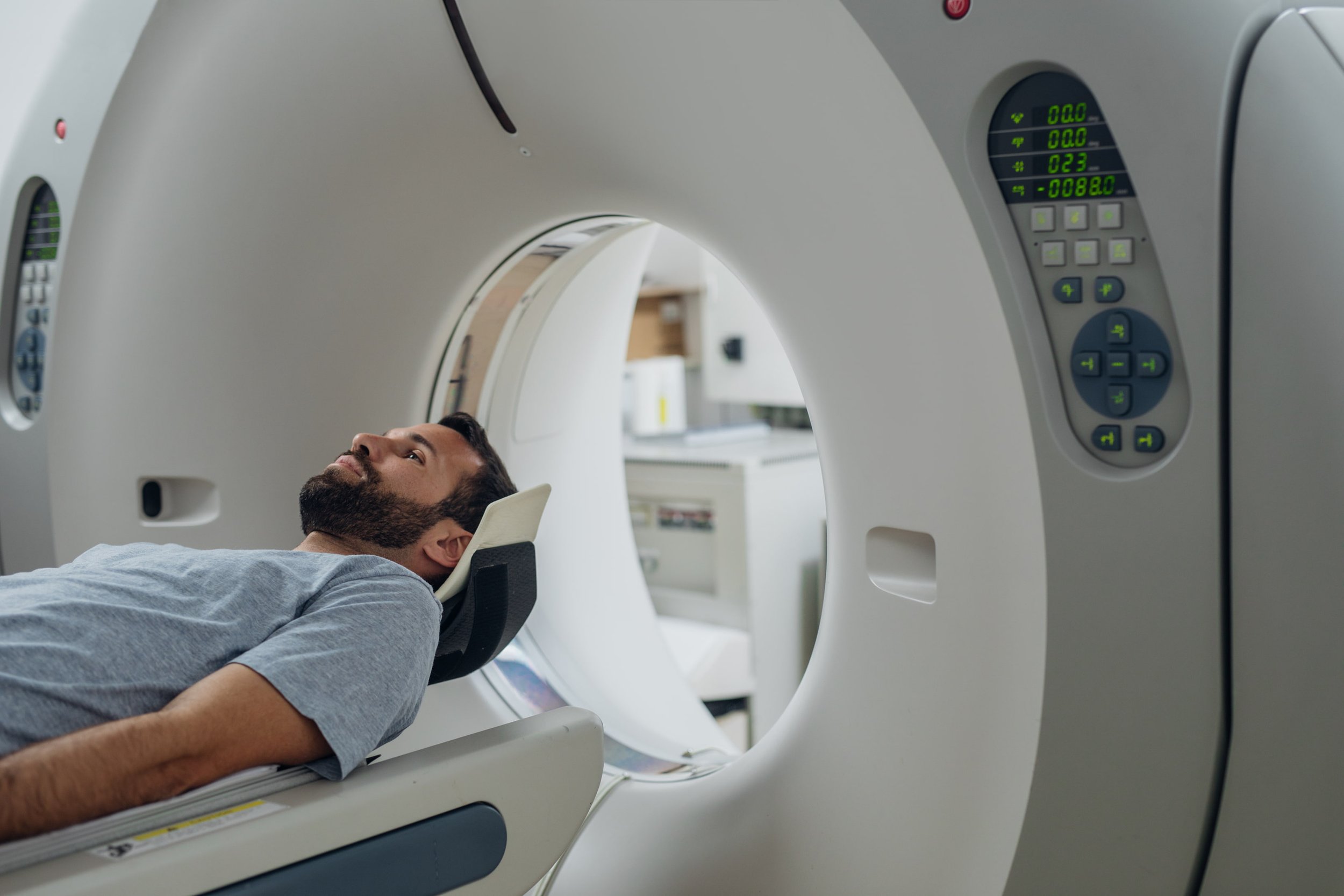
We believe that above all,
the patient comes first.


Our
Treatment Philosophy
We exist to serve you and deliver the most effective care that is clinically relevant to your treatment needs. It is for this reason that we utilize state of the art equipment combined with evidence-based treatments that are clinically proven. These enhanced techniques and equipment allow us to deliver fast treatments with higher precision and efficacy than ever before. Every aspect of our centers is designed with the patient in mind right down to the clean and comforting atmosphere that you will experience upon walking through our doors.

Our Technology.
Varian Truebeam™
Our Cancer Centers utilize the TrueBeam system for many radiotherapy treatments. The TrueBeam system is an advanced linear accelerator engineered to deliver more powerful cancer treatments with pinpoint accuracy and precision. It uniquely integrates advanced imaging and motion management technologies to deliver treatments in a shorter time while monitoring and compensating for tumor motion, opening the door to the most advanced treatments for tumors of the lung, breast, prostate, head and neck, and other locations
Safe & Reliable
Flexible treatment options
Streamlined treatments
Advanced imaging
What makes us
stand out.
Accessible Parking
Our accessible parking means that you can park within feet of our main entrance.
Leading-edge Technology.
We provide leading-edge technology to give you fast, effective, and convenient treatments close to home.
Caring Doctors.
Our physicians are leaders in their field and care well for their patients. They know that the journey through a cancer diagnosis is complex, and they are there to help guide you through.
Friendly staff
Our team of cancer care specialist exist to care well for you. When you come through our doors, we aim to treat you with the consideration and respect we would for our family.

Treatments we offer.
-
Stereotactic body radiation therapy, or SBRT, is a cancer treatment that delivers extremely precise, very intense doses of radiation to cancer cells while minimizing damage to healthy tissue. SBRT involves the use of sophisticated image guidance that pinpoints the exact three-dimensional location of a tumor so that the radiation can be more precisely delivered to cancer cells.
-
Stereotactic radiosurgery (SRS) uses many precisely focused radiation beams to treat tumors and other problems in the brain, neck, lungs, liver, spine and other parts of the body. Stereotactic Radiosurgery delivers high-intensity radiation treatments with sub-millimeter accuracy in only one to five treatment sessions. Stereotactic Radiosurgery is an outpatient procedure, and the patient can usually return to his or her usual activities the day following treatment.
-
Intensity-modulated radiation therapy (IMRT) is an advanced type of radiation therapy used to treat cancer and noncancerous tumors. IMRT uses advanced technology to manipulate photon and proton beams of radiation to conform to the shape of a tumor. The goal of IMRT is to conform the radiation dose to the target and to avoid or reduce exposure of healthy tissue to limit the side effects of treatment.
-
Image-guided radiation therapy, or IGRT, is a type of cancer treatment that uses imaging technologies such as PET, MRI, and CT to more accurately and safely deliver radiation to cancer cells. The machines that are used to deliver the radiation, called linear accelerators, are equipped with the imaging equipment so that doctors can confirm exactly where the tumor is in the body before and during treatments.
-
3D CRT, or three-dimensional conformal radiation therapy, is an advanced technique that incorporates the use of imaging technologies to generate three-dimensional images of a patient's tumor and nearby organs and tissues.
-
Additionally, we offer onsite CT scanning for your convenience. USCMC continually offers the highest level of care with the most up to date technology in all of our cancer centers. Please contact us with any needs or questions you may have.
Our Leading-edge Technology Offers:
Pinpoint Precision
The accuracy of the TrueBeam system is measured in increments less than a millimeter. This precision is made possible by synchronizing imaging, patient positioning, motion management, beam shaping, and dose delivery including accuracy checks every 10 milliseconds throughout the entire treatment.
Advanced Capabilities
For lung and other tumors subject to movement with breathing, TrueBeam offers a specialized treatment that monitors the patient’s breathing and compensates for the movement of the tumor while the dose is being delivered in a continuous rotation of the treatment machine
Faster Treatments
Treatments that once took 15-30 minutes can now be completed with greater accuracy in less than 2 minutes. This allows for a more comfortable & streamlined experience while also allowing for reduced chances of tumor motion during treatment, which helps protect the nearby healthy tissue

Testimonial
An amazing team of compassionate people laser focused on curing cancer.
- Google Review.
Common Questions
-
Most people receive radiation therapy in an effort to eliminate all cancer cells as part of a curative treatment approach. In addition to destroying cancer cells and slowing tumor growth, radiation therapy can also be used to shrink tumors and reduce pressure, pain, and other symptoms of cancer in cases when it is not possible to completely eliminate the disease. This is called palliative radiation therapy, in which the goal is to improve a person’s quality of life.
-
The goal of radiation therapy is to get enough radiation into the body to kill the cancer cells while preventing damage to healthy tissue. During external beam radiation therapy, the radiation oncology team uses a machine to direct high-energy X-rays at your cancer. Internal radiation therapy, or brachytherapy, involves placing radioactive sources (for example, radioactive seeds) inside your body.
-
During external beam radiation therapy, a beam of radiation is directed through the skin to your cancer and the immediate surrounding area using a machine called a linear accelerator. The linear accelerator, or linac, is capable of producing high-energy X-rays and electrons for the treatment of your cancer. Using high-tech treatment planning software, your treatment team controls the size and shape of the beam and how it is directed at your body, to effectively treat your tumor while sparing the surrounding normal tissue. Several special types of external beam therapy are discussed in the next sections. These are used for specific types of cancer, and your radiation oncologist will recommend one of these treatments if he or she believes it will be best for you.
Three-Dimensional Conformal Radiation Therapy (3D-CRT) Tumors are not regular – they come in different shapes and sizes. Three-dimensional conformal radiation therapy, or 3D-CRT, uses computers and special imaging techniques to show the size, shape, and location of the tumor. Computer assisted tomography (CT or CAT scans), magnetic resonance imaging (MR or MRI scans) and/or positron emission tomography (PET scans) are used to create detailed, three-dimensional representations of the tumor and surrounding organs. Your radiation oncologist can then precisely tailor the radiation beams to the size and shape of your tumor with a component of the linac called multi-leaf collimators (MLC), or custom fabricated field shaping blocks. Because the radiation beams are very precisely directed, nearby normal tissue receives less radiation and is able to heal quickly.
Intensity Modulated Radiation Therapy (IMRT)
Intensity modulated radiation therapy or IMRT, is a specialized form of 3D-CRT that allows radiation to be more exactly shaped to fit the tumor. With IMRT, the radiation beam can be broken up into many “beamlets,” and the intensity of each beamlet can be adjusted individually. Using IMRT, it may be possible to further limit the amount of radiation that is received by healthy tissue near the tumor. In some situations, this may also allow a higher dose of radiation to be delivered to the tumor, potentially increasing the chance of a cure.Stereotactic Radiotherapy Stereotactic radiotherapy is a technique that allows your radiation oncologist to precisely focus beams of radiation destroy certain types of tumors. Since the beam is so precise, your radiation oncologist may be able to spare more healthy tissue. This additional precision is achieved by using a very secure immobilization, such as a head frame used in the treatment of brain tumors. Stereotactic radiotherapy is frequently given in a single dose (sometimes called radiosurgery) although certain situations may require more than one dose. In addition to treating some cancers, radiosurgery can also be used to treat malformations in the brain’s blood vessels and certain noncancerous (benign) neurologic conditions. Sometimes a high dose of stereotactic radiotherapy can be focused upon a tumor outside the brain and given in a few treatments (typically three to eight). This form of treatment is called stereotactic body radiation therapy (SBRT).
Image-Guided Radiation Therapy (IGRT)
Radiation oncologists use image-guided radiation therapy, or IGRT, to better deliver the radiation to your cancer since tumors can move between treatments due to differences in organ filling or movements while breathing. IGRT involves conformal radiation treatment guided by imaging, such as CT, ultrasound or X-rays, taken in the treatment room just before the patient is given the radiation treatment. All patients first undergo a CT scan as part of the planning process. The imaging information from the CT scan is then transmitted to a computer in the treatment room to allow doctors to compare the earlier image with the images taken just before treatment. During IGRT, doctors compare these images to see if the treatment needs to be adjusted. This allows doctors to better target your cancer while avoiding nearby healthy tissue. In some cases, doctors will implant a tiny marker in or near the tumor to pinpoint it for IGRT. -
Most people cannot feel radiation from the machine, even during daily treatments, so there is no need to worry that a treatment session will be painful. A few people have reported a slight warming or tingling sensation in the area being treated.
-
Radiation therapy is usually well tolerated and many patients are able to continue their normal routines. However, some patients may eventually develop painful side effects. Be sure to talk to a member of your radiation oncology treatment team about any problems or discomfort you may have.
Many of the side effects of radiation therapy are only in the area being treated. For example, a breast cancer patient may notice skin irritation, like a mild to moderate sunburn, while a patient with cancer in the mouth may have soreness when swallowing. Some patients who are having their midsection treated may report feeling sick to their stomach. These side effects are usually temporary and can be treated by your doctor or other members of the treatment team.
Side effects usually begin by the second or third week of treatment, and they may last for several weeks after the final radiation treatment. In rare instances, serious side effects develop after radiation therapy is finished. Your radiation oncologist and radiation oncology nurse are the best people to advise you about the side effects you may experience. Talk with them about any side effects you are having. They can give you information about how to manage them and may prescribe medicines or changes in your eating habits to help relieve your discomfort.
The side effect most often reported by patients receiving radiation is fatigue. The fatigue patients experience is usually not severe, and patients may be able to continue all or some of their normal daily activities with a reduced schedule. However, treating cancer often requires considerable mental and physical effort. Whenever possible, try to take time during your treatment to rest and relax.
Many patients are concerned that radiation therapy will cause another cancer. In fact, the risk of developing a second tumor because of radiation therapy is very low. For many patients, radiation therapy can cure your cancer. This benefit far outweighs the very small risk that the treatment could cause cancer down the road. If you smoke, the most important thing you can do to reduce your risk of a second cancer is to quit smoking.
-
Although some types of cancer respond best to combination treatment approaches, which may include radiation plus surgery, chemotherapy, or immunotherapy, radiation therapy alone is often an effective treatment for some types of cancer.
-
Some patients are concerned about the safety of radiation therapy. Radiation has been used successfully to treat patients for more than 100 years. In that time, many advances have been made to ensure that radiation therapy is safe and effective. Before you begin receiving radiation therapy, your radiation oncology team will carefully tailor your plan to make sure that you receive safe and accurate treatment. Treatment will be carefully planned to focus on your cancer while avoiding healthy organs in the area.
Throughout your treatment, members of your team will check and re-check your plan. Special computers are also used to monitor and double-check the treatment machines to make sure that the proper treatment is given. If you undergo external beam radiation therapy, you will not be radioactive after treatment ends because the radiation does not stay in your body. However, if you undergo brachytherapy, tiny radioactive sources will be implanted inside your body, in the tumor or in the tissue surrounding the tumor, either temporarily or permanently. Your radiation oncologist will explain any special precautions that you or your family and friends need to take.
Some patients worry that radiation therapy will cause cancer years after treatment. While this is a very small risk, it is most important to cure cancer now. Talk with your radiation oncologist or radiation oncology nurse about any fears you may have.
Like all therapies, radiation can cause side effects.
-
Radiation therapy to the pelvic area can affect the reproductive system. For some women, permanent infertility (the inability to conceive a child or maintain a pregnancy) can occur, but usually only if both ovaries receive radiation. Men receiving radiation therapy to the testes or to nearby organs, such as the prostate, will have lowered sperm counts and reduced sperm activity, which affects fertility (the ability to father a child).
If you are worried your treatment plan may reduce your fertility, talk to your health care team before treatment begins. There are a number of ways to preserve your fertility.
-
Radiation therapy is a local treatment, meaning it only affects the area of the body where the tumor is located. People do not lose their hair from having radiation therapy unless it is aimed at a part of the body that grows hair, such as the scalp.
-
Get plenty of rest
Many patients experience fatigue during radiation therapy, so it is important to make sure you are well rested. If possible, ask friends and family to help out during treatment, by running errands and preparing meals. This will help you get the rest you need to focus on fighting your cancer.
Follow doctor’s orders
In many cases, your doctor will ask you to call if you develop a fever of 101° or higher. Be sure to read your instructions when caring for yourself during treatment.
Eat a balanced, nutritious diet
A nutritionist, nurse or doctor may work with you to make sure you are eating the right foods to get the vitamins and minerals you need. With certain types of radiation, you may need to change your diet to minimize side effects. You should not attempt to lose weight during radiation therapy since you need more beneficial calories due to your cancer and treatment.
Treat the skin that is exposed to radiation with extra care
The skin in the area receiving treatment may become red and sensitive, similar to getting sunburn. Your radiation oncology nurse will review specific instructions for caring for your skin with you. Some guidelines include:
Clean the skin daily with warm water and a mild soap recommended by your nurse.
Avoid using any lotions, perfumes, deodorants or powders in the treatment area unless approved by your doctor or nurse. Try not to use products containing alcohol and perfumes.
Avoid putting anything hot or cold on the treated skin. This includes heating pads and ice packs.
Stay out of the sun. If you must spend time outdoors, wear a hat or clothing to protect your skin. After treatment, use sunscreen with an SPF of at least 30.
Seek out support
There are many emotional demands that you must cope with during your cancer diagnosis and treatment. It is common to feel anxious, depressed, afraid or hopeless. It may help to talk about your feelings with a close friend, family member, nurse, social worker or psychologist. To find a support group in your area, ask your radiation oncology nurse. There are many support groups that meet in person, over the phone or on the internet.
-
A team of highly trained medical professionals will be involved in your care during radiation therapy. A radiation oncologist, a doctor who specializes in using radiation to treat cancer, leads this team.
Radiation Oncologists
Radiation oncologists are the doctors who will oversee your radiation therapy treatments. These physicians work with the other members of the radiation therapy team to develop and prescribe your treatment plan and make sure that each treatment is given accurately. Your radiation oncologist will also track your progress and adjust the treatment as necessary to make sure you receive the best care.
Radiation oncologists help identify and treat any side effects that may occur due to radiation therapy. They work closely with other cancer doctors, including medical oncologists and surgeons, and all members of the radiation oncology team.
Radiation oncologists have completed at least four years of college, four years of medical school, one year of general medical training and four years of residency (specialty) training in radiation oncology. They have extensive training in cancer medicine and the safe use of radiation to treat disease. If they pass a special examination the American Board of Radiology certifies them. You should ask if your doctor is board certified.
Medical Physicists
Medical physicists work directly with the radiation oncologist during treatment planning and delivery. They oversee the work of the dosimetrist and help ensure that complex treatments are properly tailored for each patient. Medical physicists develop and direct quality control programs for equipment and procedures. They also make sure the equipment works properly by taking precise measurements of the radiation beam and performing other safety tests on a regular basis.
Dosimetrists
Dosimetrists work with the radiation oncologist and medical physicist to carefully calculate the dose of radiation to make sure the tumor gets enough radiation. Using computers, they develop a treatment plan that can best destroy the tumor while sparing the healthy tissue.
Radiation Therapists
Radiation therapists work with radiation oncologists to give the daily radiation treatment under the doctor’s prescription and supervision. They maintain daily records and regularly check the treatment machines to make sure they are working properly.
Radiation Oncology Nurses
Radiation oncology nurses work with every member of the treatment team to care for you and your family before, during and after treatment. They will explain the possible side effects you may experience and will describe how you can manage them. They will assess how you are doing throughout treatment and will help you cope with the changes you are experiencing. If they pass a special exam, then the Oncology Nursing Exam will certify them as an Oncology Certified Nurse.
Other Healthcare professionals
You may work with a number of other healthcare professionals while undergoing radiation therapy. These specialists ensure that all of your physical and psychological needs are met during your treatment.
-
External-beam radiation therapy does not make a person radioactive at any time. The radiation is delivered to the body from a machine located in the treatment room so there is no radiation left behind once the treatment machine is turned off. However, with internal radiation therapy (also called brachytherapy), the implants placed in the patient’s body deliver most of the radiation to your cancer, but some radiation can be emitted (released). Therefore, people who receive internal radiation therapy need to take specific precautions for a period of time to reduce others’ exposure to the radiation.
